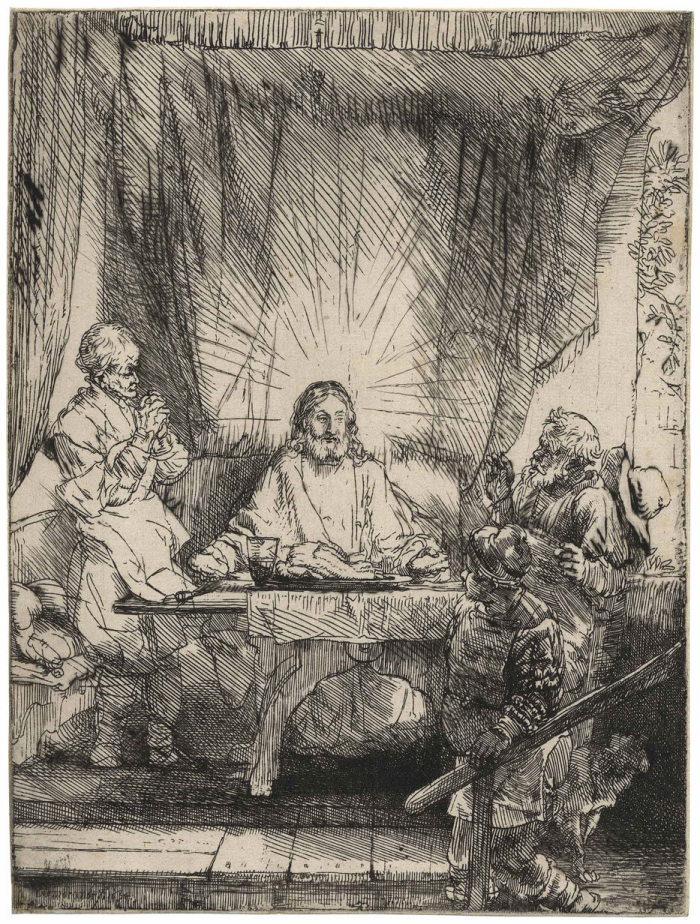Christ at Emmaus: the larger plate 1654
Rembrandt Harmensz. van Rijn 1606 Leiden – Amsterdam 1669
Christ at Emmaus: the larger plate 1654 etching and drypoint; 213 x 161 mm (8 3⁄8 x 6 5/16 inches)
Bartsch 87, White/Boon second state (of three); Hind 282; New Hollstein 283 second state (of five)
provenance
August Artaria, Vienna (Lugt 33);
his sale, Artaria & Co., Vienna, May 6–13, 1896, lot 534, described as: superbe épreuve avec beaucoup de barbes. Rare.
Julius Rosenberg, Copenhagen (Lugt 1519 and 1520);
his sale, C.G. Boerner, Leipzig, May 1–2, 1901, lot 178, described as: prachtvoller Abdruck des zweiten Zustandes, mit starkem Grat … Aus Sammlung Artaria.
Dr. Julius Elischer von Thurzóbánya, Budapest (Lugt 824)
P. & D. Colnaghi & Co., London (their stock no. in pencil on the verso C. 12793)
Percival Duxbury (1872–1945), Bredbury, Cheshire (acquired from the above in 1936)
Lilian Honor Lewis (by descent; d. 2013)
In this “larger plate” Rembrandt revisits a subject he first etched in 1634. The lively scene in the earlier print (Bartsch 88) looks like a vignette from everyday life while 20 years later the image is imbued with a monumental solemnity. Artists traditionally depict this scene showing Christ at the moment when he is breaking the bread. Rembrandt chooses the next instant, when the true identity of the traveler is revealed to the two disciples who had encountered him on their way to Emmaus (Luke 24:13–31). The translucency of the lightly etched composition fits the spiritual content at the core of the biblical story, emphasizing the ethereal figure of Christ shortly before he “vanished out of their sight.”
Christ at Emmaus belongs to a group of four vertical plates depicting scenes from the Life of Christ that are often understood as parts of a projected Passion series; the other three are The Presentation in the Temple: in the Dark Manner (Bartsch 50); The Descent from the Cross by Torch- light (Bartsch 83); and The Entombment (Bartsch 86). Christ at Emmaus and The Descent from the Cross are the only ones dated in the plate, both 1654. The solemn Presentation and the somber Descent from the Cross are both densely wrought dark compositions; the Entombment makes the transition between light and dark from the first to the second state whereas the present plate remains “lightly etched,” with only minimal, albeit effective, drypoint work added in the second state (New Hollstein’s states three through five no longer originate with Rembrandt). It is worth speculating that a fifth plate, Christ Appearing to the Apostles (Bartsch 89), this one a horizontal composition but with precisely the same measurements, dated 1656, and also known only as a “lightly etched” print, might also have been part of such a late Passion cycle.
In the purely etched first state, the head and halo of Christ appear as if they have not actually been finished—even if the survival of at least 25 impressions, according to New Hollstein, proves that Rembrandt did pull a small edition. In this, the second state, he added a lot of work, all of it in drypoint. There are more rays in the halo, and, most importantly, the face of Christ has now been completed. However, the burr on the drypoint strokes wore away quickly. The patches of burr showing in our impression along the slanted lines of the curtain and on the hat of the man on the right most effectively indicate that this is a very early pull—representing the artist’s full realization of this mature composition.
